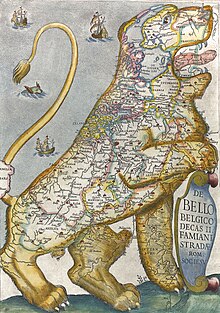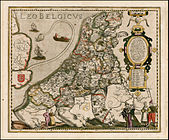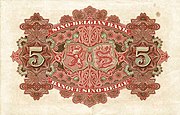
The European region known as the Low Countries, historically once also known as the Netherlands, or Belgica, is a coastal lowland region in Northwestern Europe forming the lower basin of the Rhine–Meuse–Scheldt delta and consisting today of the three modern "Benelux" countries: Belgium, Luxembourg, and the Netherlands – which English and French give the same name as the traditional regional name. Geographically and historically, the area also includes parts of France and Germany such as French Flanders and the German regions of East Frisia and Cleves. During the Middle Ages, the Low Countries were divided into numerous semi-independent principalities.

The Southern Netherlands, also called the Catholic Netherlands, were the parts of the Low Countries belonging to the Holy Roman Empire which were at first largely controlled by Habsburg Spain and later by the Austrian Habsburgs until occupied and annexed by Revolutionary France (1794–1815).

The coat of arms of Belgium bears a lion or, known as Leo Belgicus, as its charge. This is in accordance with article 193 of the Belgian Constitution: The Belgian nation takes red, yellow and black as colours, and as state coat of arms the Belgian lion with the motto UNITY MAKES STRENGTH. A royal decree of 17 March 1837 determines the achievement to be used in the greater and the lesser version, respectively.

The coat of arms of the Kingdom of the Netherlands was originally adopted in 1815 and later modified in 1907. The arms are a composite of the arms of the former Dutch Republic and the arms of the House of Nassau, it features a checkered shield with a lion grasping a sword in one hand and a bundle of arrows in the other and is the heraldic symbol of the monarch and the country. The monarch uses a version of the arms with a mantle while the government of the Netherlands uses a smaller version without the mantle (cloak) or the pavilion, sometimes only the shield and crown are used. The components of the coats of arms were regulated by Queen Wilhelmina in a royal decree of 10 July 1907, affirmed by Queen Juliana in a royal decree of 23 April 1980.
Dutch Renaissance and Golden Age literature is the literature written in the Dutch language in the Low Countries from around 1550 to around 1700. This period saw great political and religious changes as the Reformation spread across Northern and Western Europe and the Netherlands fought for independence in the Eighty Years' War.

Caspar Barlaeus was a Dutch polymath and Renaissance humanist, a theologian, poet, and historian.

The Low Countries comprise the coastal Rhine–Meuse–Scheldt delta region in Western Europe, whose definition usually includes the modern countries of Luxembourg, Belgium and the Netherlands. Both Belgium and the Netherlands derived their names from earlier names for the region, due to nether meaning "low" and Belgica being the Latinized name for all the Low Countries, a nomenclature that became obsolete after Belgium's secession in 1830.

The Dutch Maiden is a national personification of the Netherlands. She is typically depicted wearing a Roman garment and with a lion, the Leo Belgicus, by her side. In addition to the symbol of a national maiden, there were also symbolic provincial maidens and town maidens.
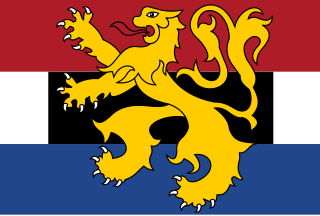
The flag of Benelux is an unofficial flag commissioned by the Committee for Belgian–Dutch–Luxembourgish Cooperation in 1951. It is an amalgam of the flags of the member states: Belgium, the Netherlands, and Luxembourg. The red stripe is from the flag of Luxembourg, the blue stripe is from the flag of the Netherlands, and the black stripe and yellow lion rampant are taken from the coat of arms of Belgium. The lion also historically represents the Low Countries area as a whole, since each constituent nation possesses a coat of arms featuring a lion rampant facing left, which during the 17th century already symbolised the Low Lands as a whole or in part.

Michaël Eytzinger, was an Austrian nobleman, diplomat, historian, and publicist, who wrote and published several works, including a renowned volume that states the principles of a genealogical numbering system, called an Ahnentafel, that is still in use today.

Claes Janszoon Visscher was a Dutch Golden Age draughtsman, engraver, mapmaker, and publisher. He was the founder of the successful Visscher family mapmaking business. The firm that he established in Amsterdam would be passed down his generations until it was sold to Peter Schenk.

Hendrik Hondius I was a Flemish-born and trained engraver, cartographer, and publisher who settled in the Dutch Republic in 1597.
Janszoon usually abbreviated to Jansz was a Dutch patronym. While Janse, Janssens, and especially Jansen and Janssen, are very common surnames derived from this patronym, the form Jansz is quite rare and Janszoon itself does not exist in the Netherlands. Notable people with this name or its variants include:

The Dutch Republic Lion was the badge of the Union of Utrecht, the Republic of the Seven United Netherlands, and a precursor of the current coat of arms of the Kingdom the Netherlands.
The Beudeker Collection is a collection of maps and views of the Netherlands and Belgium in the British Library, created by the Dutch merchant Christoffel Beudeker.

Pieter van den Keere was a Flemish engraver, publisher and globe maker who worked for the most part of his career in England and the Dutch Republic.
Nicolaes Visscher I was a Dutch engraver, cartographer and publisher. He was the son of Claes Janszoon Visscher. His son, Nicolaes Visscher II (1649–1702), also worked with him and continued the family tradition of mapmaking after his death. Visscher died in Amsterdam in 1679 and was buried in the Nieuwezijds Kapel on 11 September of that year, though a death year of 1709 is maintained by some sources.
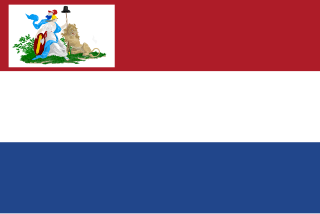
The Batavian flag is a Dutch historical flag. It was designed by Dirk Langendijk in January 1796, and introduced in March 1796 as the official flag of the navy of the Batavian Republic, replacing the Statenvlag.

National symbols of Belgium are the symbols used to represent the Kingdom of Belgium. Article 193 of the Belgian Constitution is dedicated to specifying the national flag, colours, coat of arms, and motto. It says the following: "The Belgian nation takes red, yellow and black as colours, and as state coat of arms the Belgian lion with the motto Unity makes strength."
